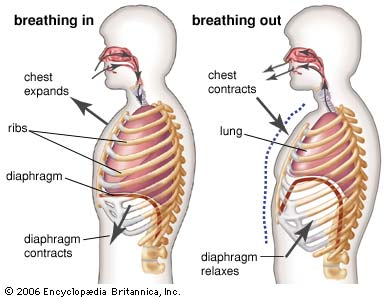So here we go. Performance tip number one of six.
Let’s get into it.
Breathing.
I’m definitely a fan of this breathing thing. And if you’re not already, you should be.
It not only keeps us alive, but it can also impact on our posture, mood, sleep, movement patterns and even training.
The fact that we perform over 20,000 breaths a day really is weird to think about, but it shows just how much possibility we have at screwing it up.
And if we do happen to screw it up at least once, we have a tendency of screwing it up constantly.
But don’t get all down and depressed about that, the good thing about breathing is that it’s pretty easy to fix.
And we can actually regress the re-training of it by going back to where most people are comfortable…
On their backs.
And despite the fact that it might not seem like breathing is hard to do, not too many people are aware they’re even doing it wrong.
How to know.
When breathing optimally, you should be inhaling some of that tasty oxygen into your lungs and allowing your diaphragm to compress downwards.
When exhaling, your diaphragm should be rising back up, like a phoenix, whilst your lungs shrink in size.

What’s cool to know is that no matter how hard you try to make your lungs super tiny by exhaling your air, you will always hold onto around 100-150ml of air in what is known as your dead space.
But, let’s say you’re in a Quasimodo-style posture for most of the day, this basic feat becomes a lot more challenging for your body to perform due to the diaphragm not being able to rise and fall and the lungs not being able to expand and contract.
And when your body can’t perform one of its most simple involuntary actions, sidekick muscles have to start to help out so, you know, you don’t blackout from not consuming enough of the precious carbon dioxide the trees are so nice to recycle for us.
Is this you?
Maybe you work at a computer all day and you’re always super tight in the neck? Or, perhaps you’re just not aware of your posture and you go about your day not thinking about it (which is fine), but you always seem to have tight or sore muscles?
People have maybe even said to you in the past that you might need to just stretch or get a weekly massage to help with the tightness/soreness. But, you’ve probably noticed that this doesn’t seem to remedy the situation at all.

And 12 hours after that intense sports remedial massage, you’re right back to square one.
An annoying cycle, indeed. But surprisingly, the same can be said for a whole lot of other tight areas in your body too.
For instance, if you suffer from a constantly tight lower back, hip flexors, hamstrings, et cetera, it can all stem back to being a result of lifestyle habits and/or posture.
Throw in a bunch of upset and tight areas and add in breathing at less than optimal levels, and you can push yourself further down Uncomfortable St.

But instead of always looking at it like you just need to pop an aspirin, stretch, foam roll, get a massage, or even cycle hot-to-cold showers, if you look to find what’s actually causing these upset areas, you’re always going to be a lot better off in the long run.
Press start.
Let’s now go back to where it all began when we were just small humanoids and our parents were too afraid for us to sleep in any position other than our backs.
It might sound simple enough (and it is), but this is only the start. And when looking further down the line of helping to create a better foundation for your breathing, being able to breathe optimally when setting up and/or performing a heavy deadlift, for example, is where you want to get to.
And it’s techniques like the Valsalva maneuver that make the beasts perform lifts like in the video below.
So let’s get into it.
Step time.
The simple steps for retraining your supine breathing are as follows:
- Lay on your back with your knees bent so that your lower back is flat to the ground. Anyone remember TT?
- Next, inhale deeply through your nose so that your entire ribcage and stomach region rises.
- Once you completely fill your torso, hold the air tight for a 3-5 second count.
- Following this, exhale forcefully via your mouth (think blowing a balloon up).
- Again, hold this emptiness for 3-5 seconds.
- Repeat.
Check out the video below to see it in action.
Fin.
Not only will breathing properly help your body to work more efficiently, but it will also help you to relax easier (seriously, try the above steps out next time you can’t fall back to sleep at that annoying 3:41am wake-up) and actually get sufficient amounts of oxygen to your brain.
Any questions, post ‘em below.



